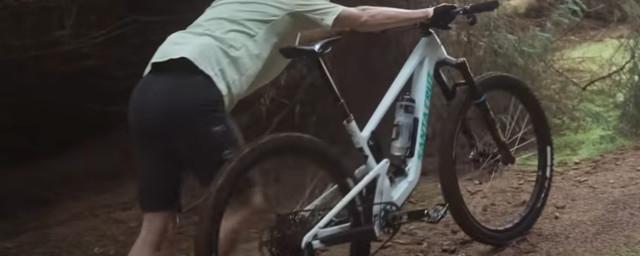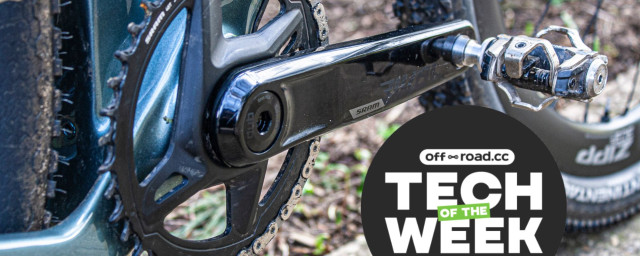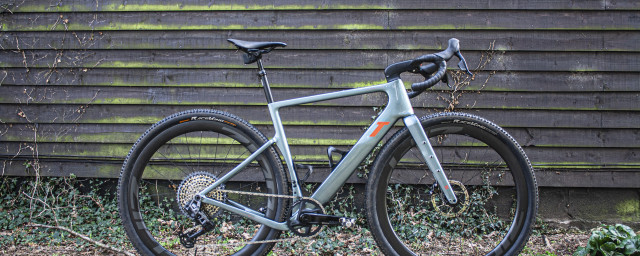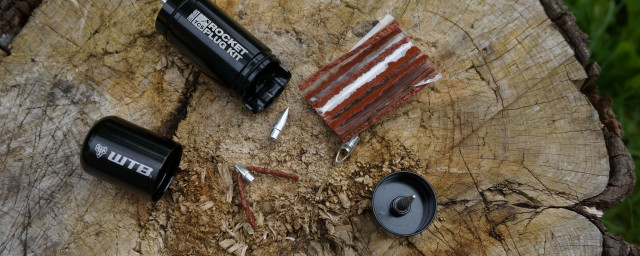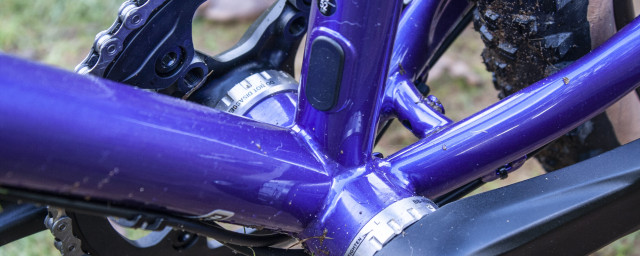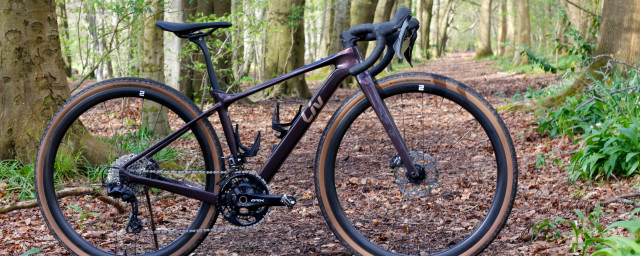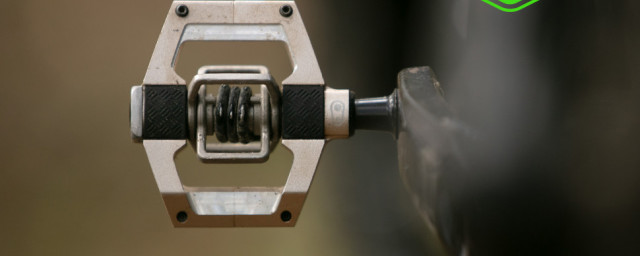Every now and then, somebody produces a product where you think, "What a great idea; I wish I'd thought of that; it's so simple." JACK the Bike Rack fits that bill perfectly. With no tools required, it fits on your bars quickly and offers a cargo platform pretty much regardless of what type of bike you have.
- 11 gravel-specific products you never knew you needed
- Ortlieb Handlebar pack QR review
- The goodness of winter gravel riding
In some ways, the JACK is not too dissimilar to an 80s-style front bag, the kind that used to hang on a quill stem on plastic-coated wire hangers for long rides. It was simple and effective, especially when preloaded to the front axle. Today's JACK is preloaded under the stem and around the steerer for a much tidier look, and more importantly, to work with suspension forks.
JACK is a front handlebar-mounted hanging rack. It's a no-frills system that requires four items to make it work. The JACK Rack, the correct handlebar diameter size adaptor, a triple stitched yellow strap (length depending on your bike/stem), and a longer black webbing retention strap with JACK written on it. OK, you might need to use the yellow bungee cords with sailing fasteners, or you might have your own voile-style straps to hold your stuff onto the JACK, but that's it.
To be clear, I have a pre-production JACK that is apparently 99% the same as the one you can buy. Talking to JACK, the company has confirmed that the welding has been tidied up, and there is an almost indistinguishable change to the hooks. So for all intents and purposes, it's the same JACK. As a consumer, you also now benefit from a 10cm longer retention strap which will aid some mountain-bike-fitting situations. Also, some of the accessories are now made from recycled polymer instead of virgin polymer. Very good to hear.
JACK is made from a 304 steel rod. This is stronger than using regular steel and aluminium parts, and it has the added bonus that it will not rust. Ours is left in its raw state, which looks great. The black webbing deck fabric is an ultra-tough 1000 denier, which is generally associated with heavy-duty bags. This material feels unlikely to rip/tear regardless of what you do to it. As an added bonus, it also prevents you from getting face splatter on mucky descents.
The triple-stitched nylon yellow strap can take a dynamic weight of 300kg, so your cargo should be OK hanging on the underside of the stem. The final JACK strap has a stainless-steel buckle which should last for ages.
JACK installation
After watching the simple video instructions, fitting was, oh, a whole two minutes, if that. Swapping between bikes regularly has meant I can now do it in about 30 seconds if I remember which bike uses which length yellow strap. Almost all my bikes use 31.8mm handlebars, so I didn’t need to change the bar mount bracket. Although older style 25.4mm bars are accommodated and tested, 35mm bars are not.
The JACK Rack works by slotting either side of your stem with a snap-on fit. I’ve found that square-sided stems fit better than sculpted ones for initial side-to-side movement. Still, it doesn't matter once the retention strap is fitted and the system preloaded.
Once you've snapped it on, you need to swing the rack up so that you can access the little strap hook on the back of the large handlebar hook to slip on a yellow strap. I went for medium first from the different size options (XS, S, M, L and XL), and it was the correct choice on the first bike.
Once the strap is fitted to both little hooks under your stem, you then lower the JACK into the riding position to check whether you have enough tyre clearance and adjust the rack's angle. Just slightly up at the front, not quite horizontal, works best at this stage.
You'll need to be careful of your brake and gear cables and may need to place some behind the rack and some in front, as I had to on my mountain bike. I didn't need to reroute any of the cables on any of the bikes I tried. However, some required more careful hooking of the JACK over the bars than others.
Next, you need to preload the rack to prevent it from bouncing up and down as you ride. This is simply done by threading the retention strap through the vertical brackets and around the back of your steerer tube. You will need some space between the bottom of the stem and the headset for this to work, so if you have no spacers, you might need to be more creative around the bottom of the head tube.
I found the retention strap a little short for some situations, such as using the lower brackets to loop the strap around the back of the headtube where it meets the downtube. For this, I used my own to test it. All new JACKs will have a 10cm-longer strap for this situation.
As you tighten the retention strap and push down on the rack, I’ve found that sometimes a friend can help here, but it is possible to do it on your own. Once preloaded, the rack feels solid with very little movement up and down, and that small amount of sway at the stem has all but gone.
So fitting the JACK takes less time than reading the first paragraph in this review, and it's a solid platform for whatever you want. So far, I've run it on four bikes - two gravel bikes, a mountain bike, and a commuting e-bike. I've had to move my Garmin and light mounts, but that's a small price to pay for such a convenient cargo option.
The JACK capacity
The JACK rack is rated at 5kg – it has apparently passed safety tests at much higher loads. Still, I’ve kept as close as possible to that limit throughout my testing period. I’ve carried large rucksacks, carted all my work kit for a day in the office, including heavy books, laptop, and all the usual kit I’d shove in a small pannier or two; I’ve even carried logs and bikepacking kit. It really is very versatile.
Riding with the JACK
In terms of use, once fitted, you barely notice it. The JACK feels very solid, and there are no issues when riding in or out of the saddle. There is a slight sideways wobble if you push it back and forth with your hand when stationary, but it's not detectable once riding. With a good 5kg load upfront and the retention strap tight, riding rutted towpaths and out-of-the-saddle lung-busting hills, I just forgot about the rack, which has to be the best recommendation of all.
So the JACK is a perfect bit of kit that snaps on and off my 31.8mm bars and fits pretty much all my bikes without a problem. Well, almost – you need to be aware of the minimum height requirement between the tops of your bars and the top of your tyre. JACK recommends a minimum of 225mm, so pay attention to this; otherwise, you might find your tyre catching in the bottom of the rack.
The only issue I found when using the JACK was when it came to trying it on some 25.4mm bars, which necessitated a change of bar adaptors. The 31.8mm ones popped out fairly easily, but fitting the 25.4mm adaptors was pretty tough, though that was nothing compared with getting them back off again. On a scale of one to 10, with 10 being impossible, I’d give that an 8 for difficulty. It’s because there is a lot more plastic on the 25.4mm adaptors to push/bend than on the 31.8mm adaptors. I nearly gave up and phoned a friend, but eventually, my thumbs won. If you are doing this swap regularly, make sure everything is not straight from the garage/shed and cold: take it into the kitchen and warm it up first. And do plenty of thumb exercises.
That’s the only slow part of the process and probably won’t affect many of you.
Value & verdict
In terms of value, it seems rather good owing to its almost universal fit and simplicity of fitting. At £60, it doesn't seem that steep when you consider the capacity it can handle, when many bar bags are heading in that direction or realistically at least twice that price.
The market has many bolt-on options that offer the same solution (albeit with greater weight capacity). Still, these are semi-permanent and require specific fork mounts which might not be available to you. They range from about £100 upwards from brands such as Surly and Pelago. BiKase makes a wire hang-on device that hooks over the bars and rests against your head tube but is designed for city use with no straps or mounts to keep it from bouncing. It will also wear your paint fast on your head tube. The only other options appear to be bag-and-bar mount systems from Ortlieb, Aeroe, and Salsa, but these are not carry-anything platforms.
So how can you get one? On Indiegogo at the moment for £58 and delivery in July. It's a long way off, but regular units will not be available till September, and the cycling world is getting used to these long delays now.
So JACK the Bike Rack is an almost universal fit (tyre to bar minimum measurement accepted). It fits in seconds and can carry a wide variety of kit. You can use it off-road on gravel and bikepacking adventures, and you can use it to go to work. My paddleboard even fits on, but it does weigh almost double the official 5kg limit. Basically, you can use this rack to carry anything you like, and it will do it well without bouncing or wobbling. It's a good value at £60, and you can move it from bike to bike, and you don't need specialist fork mounts. I think it's a winner.










